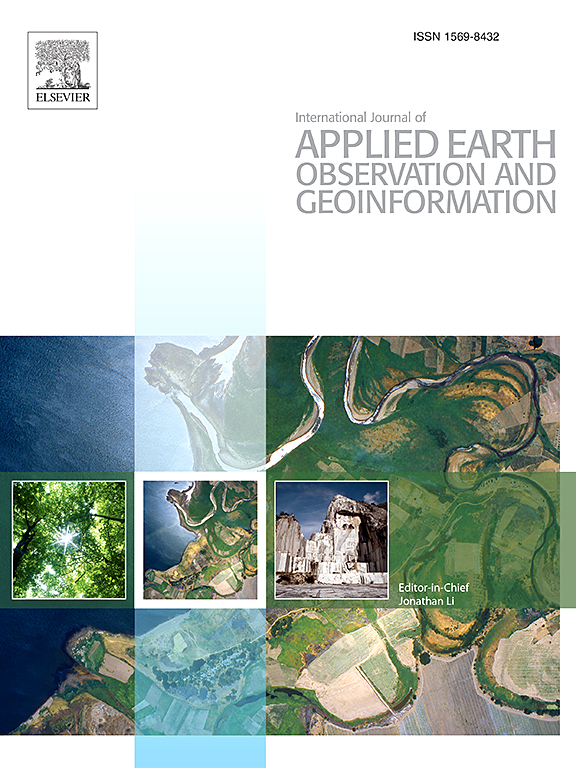Enhancing drone-based fire detection with flame-specific attention and optimized feature fusion
IF 7.6
Q1 REMOTE SENSING
International journal of applied earth observation and geoinformation : ITC journal
Pub Date : 2025-06-18
DOI:10.1016/j.jag.2025.104655
引用次数: 0
Abstract
Recent advancements in drone-based fire early warning technologies have significantly improved fire detection, particularly in remote and forested areas where drones are widely utilized. However, the constrained battery life and limited computational resources of drones present challenges for real-time fire detection. Existing methods primarily focus on fire target identification without considering the distinct color and thermal characteristics of flames, leading to suboptimal detection accuracy. To address these issues, we propose a Flame-Specific Attention (FSA) mechanism, which integrates heat conduction principles and flame shape features to enhance receptive field expansion while maintaining computational efficiency. Furthermore, the Neck of the model is optimized with a Focal Modulation module to improve feature fusion, and a variable multi-attention detection head is introduced to refine detection precision. Experimental results on our Comprehensive Fire Scene Dataset (containing 3,905 images) demonstrate that our model achieves a mean Average Precision ([email protected]) of 87.7%, surpassing both Vision Transformers (ViTs) and traditional CNN approaches. Compared to the YOLOv10 baseline, our approach improves precision by 5.7% while maintaining an inference speed of 182 FPS, enabling real-time deployment in edge-computing scenarios such as drone-based fire detection. Additionally, the model effectively detects small- and medium-sized flames, reducing false positives in challenging lighting conditions (e.g., sunset and urban illumination). These enhancements make our approach highly suitable for early fire warning applications in forest and urban environments.
通过火焰特异性关注和优化特征融合增强基于无人机的火灾探测
基于无人机的火灾预警技术的最新进展显著改善了火灾探测,特别是在无人机广泛使用的偏远和森林地区。然而,无人机有限的电池寿命和有限的计算资源给实时火灾探测带来了挑战。现有的方法主要集中在火灾目标的识别上,没有考虑火焰的不同颜色和热特性,导致检测精度不理想。为了解决这些问题,我们提出了一种火焰特定注意(FSA)机制,该机制集成了热传导原理和火焰形状特征,以增强感受场扩展,同时保持计算效率。此外,利用焦调制模块对模型颈部进行优化,提高特征融合,并引入可变多注意检测头,提高检测精度。在我们的综合火灾现场数据集(包含3,905张图像)上的实验结果表明,我们的模型达到了87.7%的平均精度([email protected]),超过了视觉变形器(ViTs)和传统的CNN方法。与YOLOv10基线相比,我们的方法将精度提高了5.7%,同时保持了182 FPS的推理速度,可以在边缘计算场景(如基于无人机的火灾探测)中实时部署。此外,该模型有效地检测中小型火焰,减少在具有挑战性的照明条件下的误报(例如,日落和城市照明)。这些改进使我们的方法非常适合森林和城市环境中的早期火灾预警应用。
本文章由计算机程序翻译,如有差异,请以英文原文为准。
求助全文
约1分钟内获得全文
求助全文
来源期刊

International journal of applied earth observation and geoinformation : ITC journal
Global and Planetary Change, Management, Monitoring, Policy and Law, Earth-Surface Processes, Computers in Earth Sciences
CiteScore
12.00
自引率
0.00%
发文量
0
审稿时长
77 days
期刊介绍:
The International Journal of Applied Earth Observation and Geoinformation publishes original papers that utilize earth observation data for natural resource and environmental inventory and management. These data primarily originate from remote sensing platforms, including satellites and aircraft, supplemented by surface and subsurface measurements. Addressing natural resources such as forests, agricultural land, soils, and water, as well as environmental concerns like biodiversity, land degradation, and hazards, the journal explores conceptual and data-driven approaches. It covers geoinformation themes like capturing, databasing, visualization, interpretation, data quality, and spatial uncertainty.
 求助内容:
求助内容: 应助结果提醒方式:
应助结果提醒方式:


